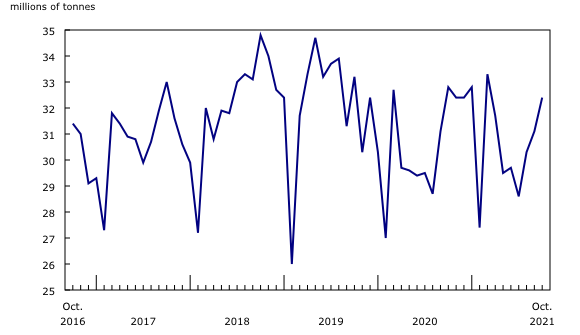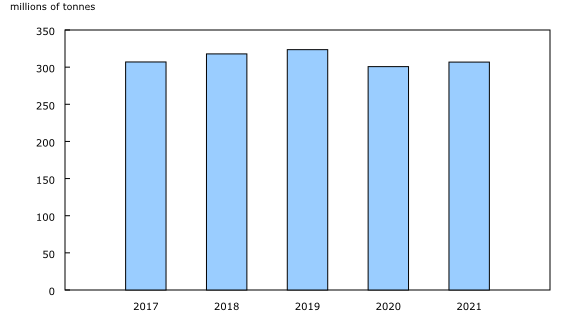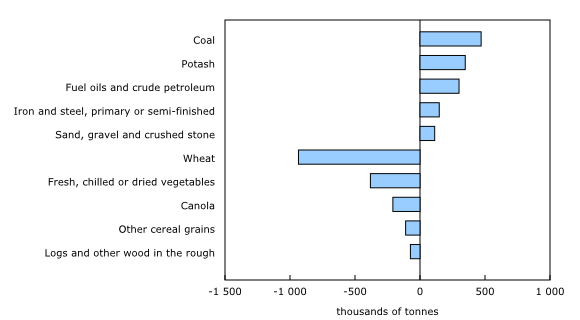Railway carloadings, October 2021
Archived Content
Information identified as archived is provided for reference, research or recordkeeping purposes. It is not subject to the Government of Canada Web Standards and has not been altered or updated since it was archived. Please "contact us" to request a format other than those available.
Released: 2021-12-24
32.4 million metric tonnes
October 2021
-1.2% 
(12-month change)
Highlights
Canadian railways transported 32.4 million tonnes of freight in October, down 1.2% from October 2020 and following a similar year-over-year decline in September.
Despite this small decrease, total freight carried was just under the five-year average of 33.0 million tonnes for October, as increases in energy and steel product shipments helped to offset a large decline in grain shipments.
To further explore current and historical data in an interactive format, please visit the Monthly Railway Carloadings: Interactive Dashboard.
Loadings lag behind pre-pandemic levels
In the 10-month period from January to October 2021, the total cargo volume moved by rail amounted to 306.8 million tonnes. While this cumulative total was up 2.0% from the same period in 2020, it was still 5.2% below the level observed for January to October 2019, before the pandemic.
Grains lead decline
October's decline in total freight carried reflected a lower volume of domestic loadings, both non-intermodal and intermodal (containers).
Domestic non-intermodal freight traffic was down 2.1% year over year to 25.6 million tonnes in October, mainly as a result of ongoing declines in some agricultural and food products—notably grains.
With the depletion of grain stocks after a record year in 2020, along with lower crop production because of the summer 2021 drought across the Prairies, grain shipments by rail have been decreasing in recent months. For instance, loadings of wheat, which have declined year over year for six straight months, were down 38.9% (-935 000 tonnes) in October—the largest drop in almost 20 years.
Similarly, loadings of fresh, chilled or dried vegetables posted a year-over-year decrease for an eighth consecutive month, down 70.2% (-381 000 tonnes) in October, following a large decline in September (-49.7%).
Loadings of canola dropped 16.1% (-209 000 tonnes) in October, an eighth consecutive monthly year-over-year decline, while loadings of other cereal grains were down 12.7% (-111 000 tonnes).
Other significant decreases were also reported for loadings of logs and other wood in the rough, down 77.6% (-74 000 tonnes) in October from the same month a year earlier.
Energy products trending up
As countries gradually lifted COVID-19-related restrictions over the summer and into the fall, sparking a rise in fuel consumption and industrial production, global demand for energy products continued to climb. Loadings of coal grew 15.7% (+470 000 tonnes) from October 2020, following a significant jump recorded in September (+22.1%).
Loadings of fuel oils and crude petroleum have risen year over year for six straight months, up 36.7% (+300 000 tonnes) in October, following even stronger gains in September (+49.9%) and August (+115.8%). According to Canadian international merchandise trade data, Canada's exports of energy products recorded large year-over-over increases in October, September and August.
In addition, loadings of primary or semi-finished iron and steel, which have risen year over year since February 2021, grew by 53.7% (+148 000 tonnes) in October. This followed substantial gains in September (+73.7%) and August (+111.3%), closely tracking year-over-year increases in primary metal manufacturing sales, as shown by data from the Monthly Survey of Manufacturing.
Finally, loadings of potash rose 21.3% (+348 000 tonnes) over the same period, after a 16.7% decline in September, while loadings of sand, gravel and crushed stone were up 36.0% (+113 000 tonnes).
Domestic intermodal traffic waning
After posting year-over-year increases for 11 consecutive months, intermodal shipments originating from Canada—mainly containers—declined for the second month in a row, down 14.6% year over year in October. The 3.1 million tonnes loaded in October constitute the lowest traffic for this month in five years. Ongoing disruptions in global supply chains, including a shortage of containers and congestion at ports, continued to affect global shipping. Canada's imports of consumer goods edged down year over year for a fourth straight month in October, according to Canadian international trade data.
American freight remains up
In October, freight traffic arriving from the United States remained well above the volume of previous years for the eighth consecutive month, up 23.2% to 3.7 million tonnes.
British Columbia flooding impacts rail
In November, flooding and landslides damaged transportation infrastructure in British Columbia, resulting in major disruptions to goods moving to and from key ports on the west coast. The Port of Vancouver—Canada's gateway to the Pacific—was cut off from the rest of the country as rail shipments into and out of the port were halted.
The Port of Vancouver is critical for exporting several key commodities—notably agricultural products and coal—so these disruptions will have a discernable impact on November railway carloadings. These data are slated for release on January 27, 2022.
Note to readers
The Monthly Railway Carloadings Survey collects data on the number of rail cars, tonnage, units and 20-feet equivalent units from railway transporters operating in Canada that provide for-hire freight services.
Cargo loadings from Armstrong, Ontario, to the Atlantic coast are classified to the eastern division (eastern Canada), while loadings from Thunder Bay, Ontario, to the Pacific coast are classified to the western division (western Canada).
Survey data are revised on a monthly basis to reflect new information.
The data in this release are not seasonally adjusted.
The Transportation Data and Information Hub provides Canadians with online access to comprehensive statistics and measures on the country's transportation sector.
Contact information
For more information, or to enquire about the concepts, methods or data quality of this release, contact us (toll-free 1-800-263-1136; 514-283-8300; infostats@statcan.gc.ca) or Media Relations (statcan.mediahotline-ligneinfomedias.statcan@statcan.gc.ca).
- Date modified:




